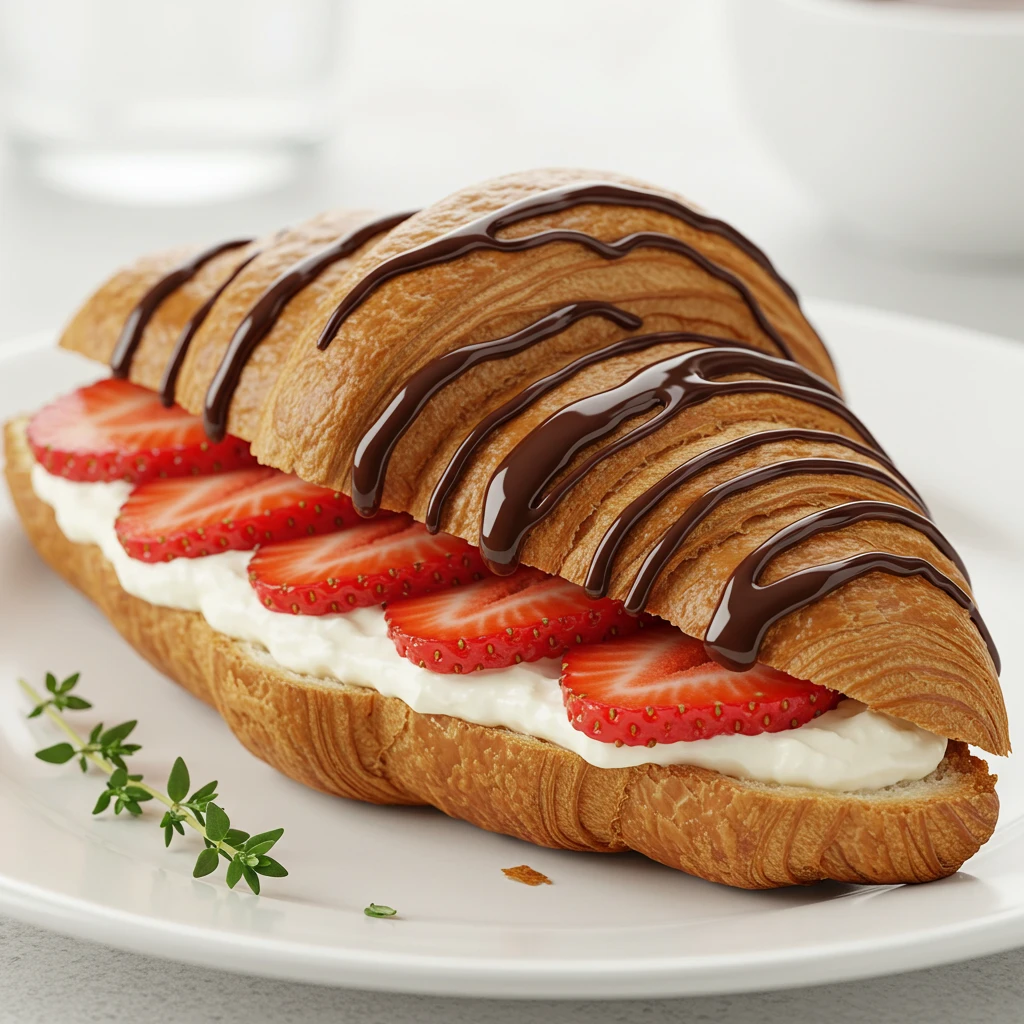Growing up, my grandmother had a way of making everything feel special. One of her most memorable treats was a strawberry croissant. I remember the scent of freshly baked pastry wafting through the house as she carefully prepared the dough. Each time, she would add a fresh layer of strawberry jam, carefully wrapping it into the flaky croissant. It was an experience that filled the senses, and every bite was a perfect combination of buttery richness and sweet strawberry goodness. It was in those moments that I first realized how versatile and satisfying a strawberry croissant can be.
Table of Contents
This childhood experience sparked my lifelong fascination with strawberry croissants. Over the years, I’ve come to appreciate the artistry of this delicious pastry, from its French origins to the many variations it has inspired worldwide. In this guide, we will explore everything from the history and evolution of the strawberry croissant to practical tips for making them at home, as well as alternative fillings and variations.
Whether you are a seasoned baker or someone who simply enjoys a warm pastry with coffee, this comprehensive guide will provide you with a thorough understanding of the strawberry croissant. So, let us dive into the delicious world of these irresistible treats!

What is a Strawberry Croissant?
What Defines a Strawberry Croissant?
A strawberry croissant is a variation of the classic French croissant, which features layers of flaky, buttery dough filled with strawberries. The filling can be fresh strawberries, strawberry jam, or a mixture of both, depending on the desired sweetness and texture. Typically, these croissants are enjoyed as a sweet pastry, making them a popular breakfast treat or dessert. The contrast between the flaky outer layers of the croissant and the juicy, flavorful strawberry filling creates a perfect balance of textures and tastes.
What sets the strawberry croissant apart from other fruit-based pastries is its delicate preparation. The dough is made using a technique known as lamination, which involves folding layers of butter into the dough to create its signature light and flaky texture. The addition of strawberries, whether fresh or preserved, brings a natural sweetness that pairs beautifully with the richness of the croissant.
History and Origins of the Strawberry Croissant
The strawberry croissant is a relatively modern variation of the classic croissant, which itself has a fascinating history. The croissant’s roots can be traced back to the 17th century in Austria, where it was known as the “kipferl.” The pastry made its way to France, where it was refined and became the buttery, flaky treat that we know today. Over the years, bakers began experimenting with different fillings, and the addition of fruit, particularly strawberries, became a natural progression. The strawberry croissant likely evolved from these culinary experiments and quickly gained popularity, especially in bakeries and cafes where fresh fruit pastries are in high demand.
The strawberry croissant is not only a culinary innovation but also a symbol of how traditional French pastries continue to adapt and inspire new creations.
The Evolution of Croissants
The Traditional French Croissant vs. Strawberry Croissant
The French croissant is a quintessential pastry known for its light, buttery texture. It is made from a laminated dough that undergoes a series of folds and rolls to create thin layers of dough and butter. These layers puff up during baking, resulting in a pastry that is both flaky and tender. A traditional croissant is often eaten plain or filled with savory ingredients like ham and cheese, making it suitable for breakfast or a light meal.
In contrast, the strawberry croissant is a sweetened variation that adds a fruit-filled twist to the classic croissant. The strawberry filling can either be a rich jam or fresh, juicy strawberries. The sweet filling is what distinguishes the strawberry croissant from its more neutral counterpart. While the classic French croissant is beloved for its simplicity, the strawberry croissant offers a refreshing burst of sweetness, making it a favorite among those who enjoy fruity pastries. The introduction of the strawberry croissant is part of a larger trend of incorporating fresh fruits into pastries, a trend that has continued to evolve as chefs experiment with different fillings and flavor profiles.
How Strawberry Croissants Came to Be
The strawberry croissant likely emerged as bakers began experimenting with fruit-filled pastries to diversify their offerings. France has a long tradition of fruit-based desserts, from tarts to soufflés, so it is only natural that strawberries, one of the most popular fruits in the country, would make their way into the croissant world. The introduction of strawberry jam and fresh strawberries as croissant fillings was a simple yet brilliant innovation that brought a natural sweetness to the rich, buttery dough.
The strawberry croissant also benefits from the seasonal availability of strawberries, particularly in spring and summer, making it an ideal pastry for those months. Over time, the strawberry croissant grew in popularity, appearing in bakeries and cafes worldwide. Its appeal lies not only in its delicious flavor but also in its versatility whether served as a quick breakfast on the go or as an indulgent dessert.
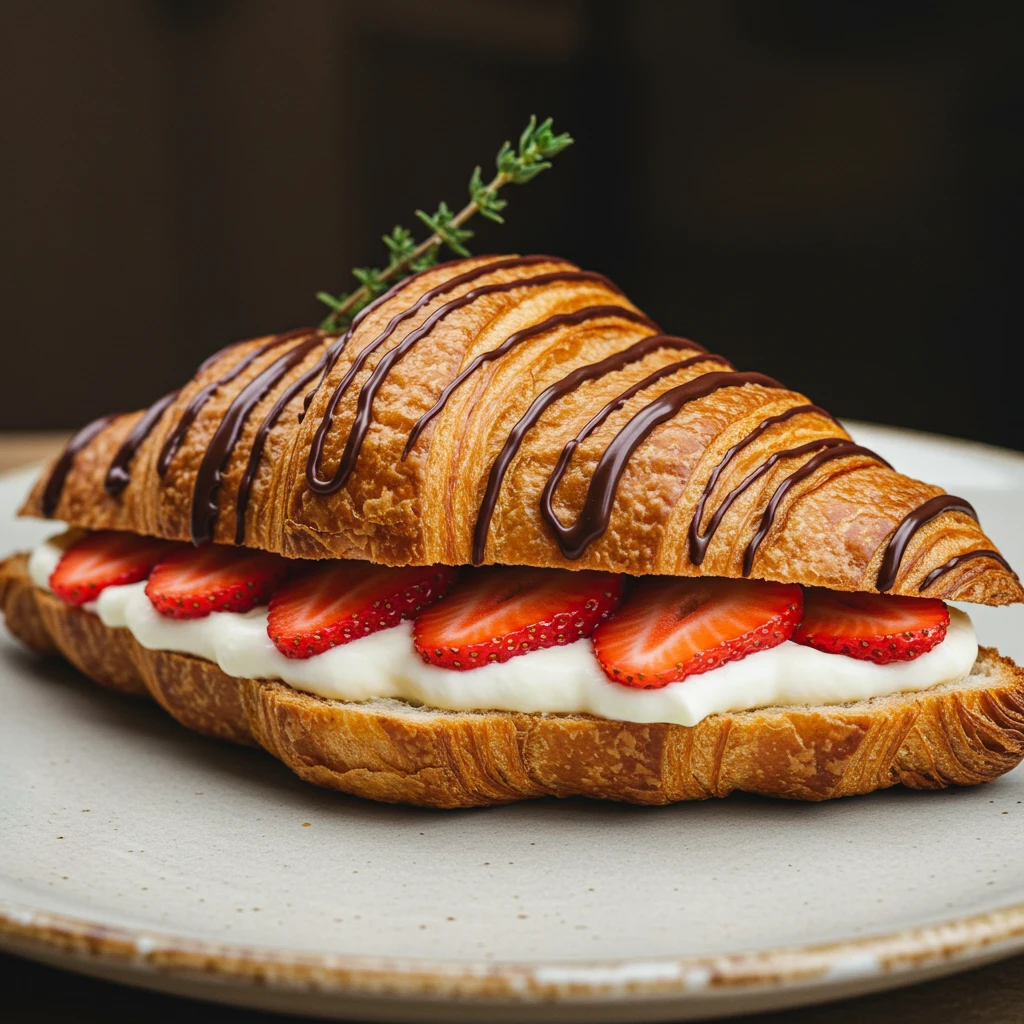
How to Make Strawberry Croissants at Home
Step-by-Step Guide to Making a Strawberry Croissant
Making strawberry croissants at home may seem intimidating at first, but it is a rewarding process. Here is a step-by-step guide to help you create these delectable pastries from scratch.
- Prepare the Croissant Dough: Begin by making the laminated dough. This involves mixing flour, yeast, sugar, salt, milk, and butter to form a dough. Let the dough rise for an hour before rolling it out.
- Laminate the Dough: Roll the dough into a rectangle and fold in cold butter, repeating this process to create layers. Let the dough chill between folds to maintain the butter’s consistency.
- Shape the Croissants: Once the dough is ready, roll it out into a thin sheet and cut it into triangles. Place a spoonful of strawberry jam or fresh strawberries in the center and roll them up into a crescent shape.
- Proof the Croissants: Allow the croissants to rise for an hour before baking to ensure they puff up during the baking process.
- Bake the Croissants: Preheat your oven to 375°F (190°C) and bake the croissants for 15–20 minutes, or until they are golden brown and flaky.
- Serve: Once baked, let the strawberry croissants cool slightly, then enjoy them warm with a light dusting of powdered sugar.
Essential Ingredients for Strawberry Croissants
To make strawberry croissants, you will need the following ingredients:
- For the dough: All-purpose flour, yeast, milk, sugar, butter, and salt.
- For the filling: Fresh strawberries, strawberry jam, or a combination of both.
- For the finish: Egg wash (a mixture of egg and water) to give the croissants a golden color, and powdered sugar or glaze for decoration.
Tips for Perfecting Your Strawberry Croissants
- Keep the butter cold: Cold butter is essential for creating the flaky layers in the croissant dough.
- Don’t overfill: Be careful not to add too much filling, as this can cause the croissants to leak during baking.
- Let the dough rest: Allow the dough to chill between folds and after shaping to ensure a light, airy texture.
- Use quality ingredients: Fresh, high-quality strawberries and butter will elevate the flavor of your strawberry croissants.
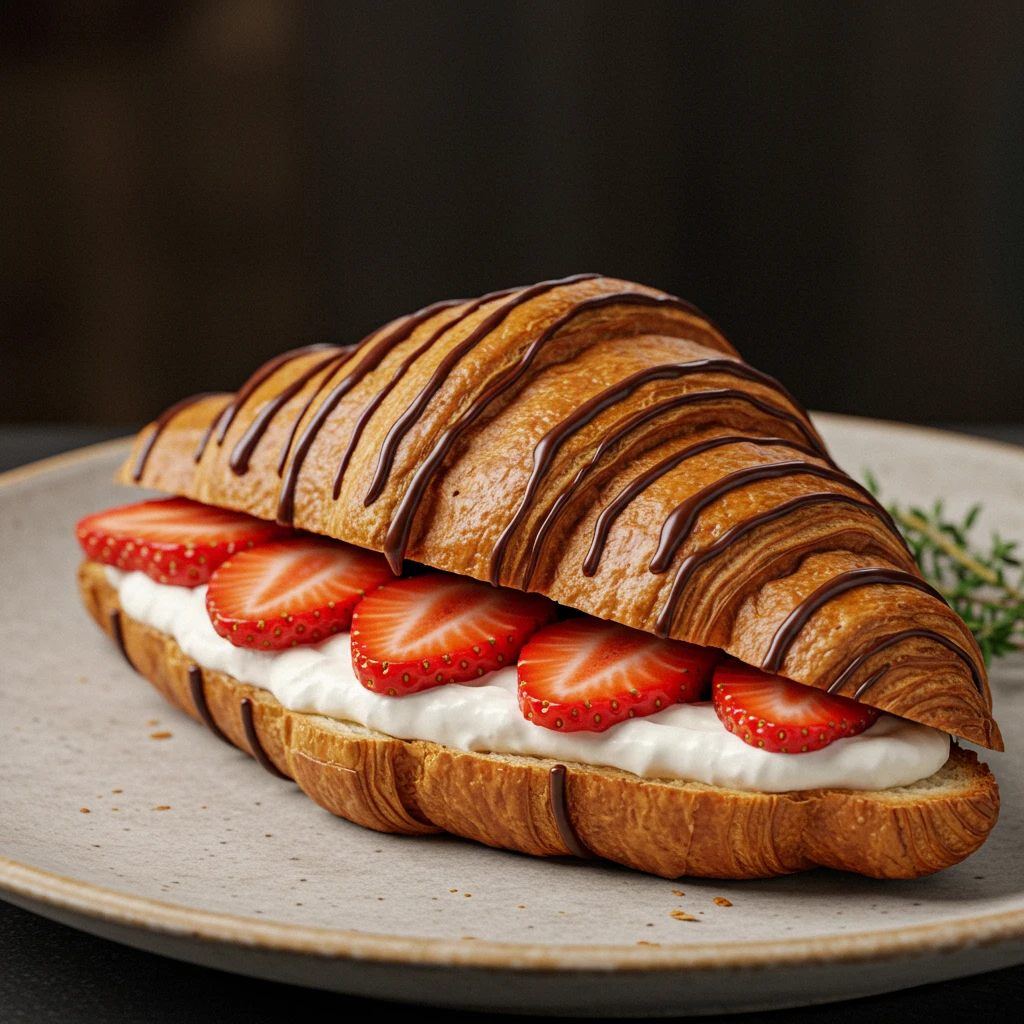
Strawberry Croissant Filling Ideas and Variations
Classic Strawberry Jam or Fresh Strawberries?
One of the first decisions when making strawberry croissants is whether to use strawberry jam or fresh strawberries. Both options offer unique benefits:
- Strawberry Jam: The advantage of using strawberry jam is its consistency and sweetness. Jam provides a smooth, evenly spread filling that doesn’t leak as easily during baking.
- Fresh Strawberries: Using fresh strawberries creates a juicier, more natural filling that bursts with flavor. To avoid too much liquid, I recommend slicing the strawberries and macerating them with a little sugar to draw out the juices before using them as a filling.
Combining both fresh strawberries and strawberry jam can offer the best of both worlds natural fruit flavor with the richness of jam.
Exploring Unique Fillings and Toppings for Strawberry Croissants
While the traditional strawberry croissant uses simple strawberry jam or fresh strawberries, there are several ways to make this pastry even more exciting:
- Strawberry and Cream Cheese: Add a dollop of cream cheese to your filling for a creamy contrast to the tartness of the strawberries.
- Strawberry and Chocolate: For an indulgent twist, add a layer of chocolate ganache or melted chocolate inside the croissant before adding the strawberries.
- Strawberry and Almond: Combine sliced almonds with strawberry jam for a crunchy texture and a nutty flavor that pairs beautifully with the sweet strawberries.
These creative variations can help you elevate your strawberry croissants and tailor them to your personal taste.
Is Strawberry Croissant Healthy?
Nutritional Information of a Strawberry Croissant
While strawberry croissants are delicious, they are also quite calorie-dense due to the high butter content in the dough. The typical strawberry croissant contains approximately 300-400 calories, with most of the calories coming from fats and sugars. The fruit filling adds some nutritional value, but it doesn’t significantly reduce the overall calorie count.
Here is a rough nutritional breakdown for one strawberry croissant:
- Calories: 300-400 kcal
- Fat: 15-20 grams (mainly from butter)
- Carbohydrates: 35-45 grams (including sugars)
- Protein: 4-6 grams
- Fiber: 1-2 grams (from the strawberries)
Can You Make a Healthier Strawberry Croissant?
To make a healthier version of the strawberry croissant, consider these modifications:
- Use whole wheat flour: Whole wheat flour increases fiber content, making the croissants a little more filling.
- Reduce the butter: Swap some of the butter for a lighter alternative like olive oil or margarine.
- Use fresh strawberries: Opt for fresh strawberries instead of strawberry jam, as jam often contains added sugars and preservatives.
While the strawberry croissant may not be the healthiest pastry option, these adjustments can make it a more nutritious treat when enjoyed in moderation.
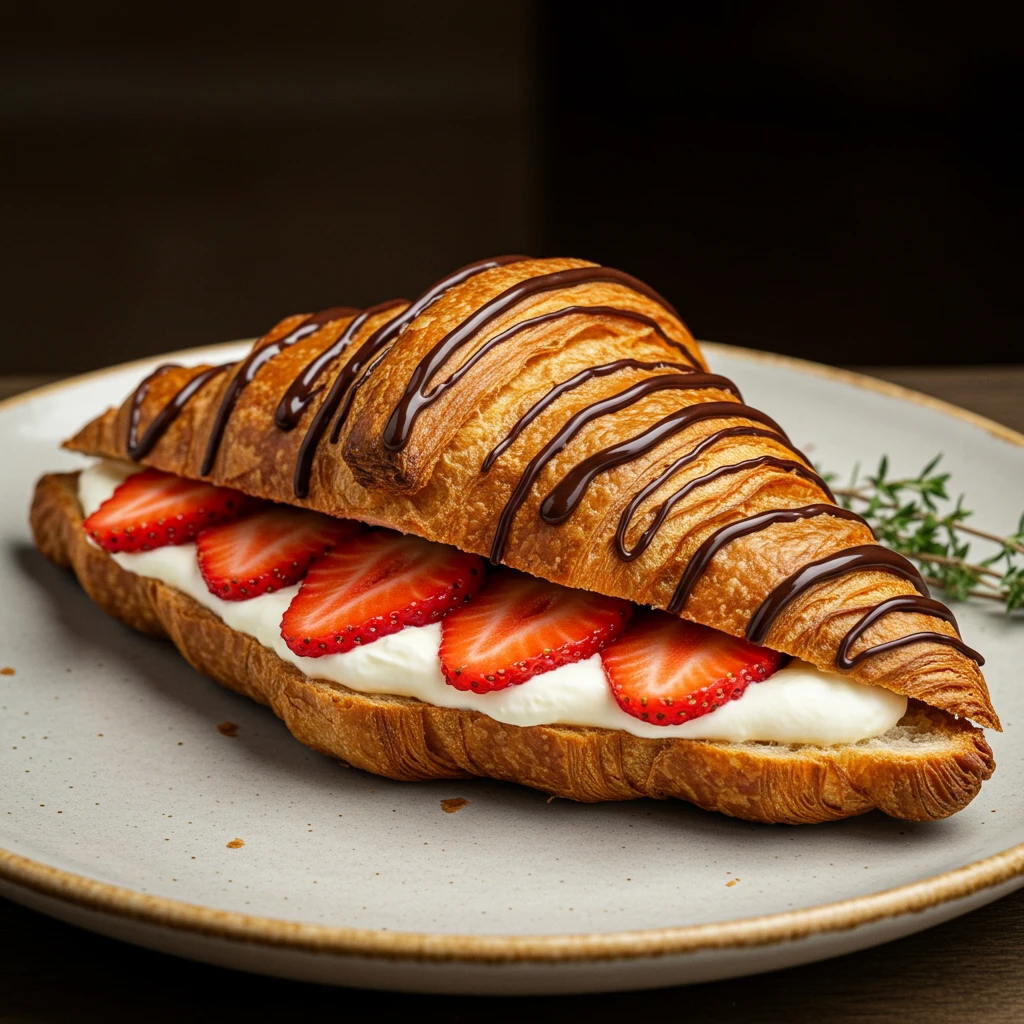
Strawberry Croissants in French Culture
The French Connection: Croissants as a Cultural Icon
In France, the croissant is more than just a pastry it is a cultural icon. Its buttery, flaky layers symbolize French craftsmanship and culinary tradition. The croissant has a long history, originating in Austria as the kipferl before being perfected in France. Today, croissants are enjoyed by millions, and their preparation is taken seriously by French bakers who pride themselves on creating the perfect flaky layers.
The strawberry croissant is a modern variation, but it still carries with it the essence of French baking tradition. While not as entrenched in history as the traditional croissant, the strawberry croissant has become popular worldwide, adding a fruit-filled twist to this beloved pastry.
What Makes French Croissants Different from Other Countries?
French croissants are distinct due to their unique preparation process. The technique of laminating dough with butter creates the signature flaky layers. Other countries may have their own versions of croissants, but the French method ensures a lighter, airier texture that is hard to replicate.
French croissants are also known for their quality ingredients, such as high-quality butter, which contributes to their rich, buttery flavor. In addition, croissants in France are often served fresh, making them a true culinary experience.
How to Pair Strawberry Croissants with Beverages
Best Beverages to Serve with Strawberry Croissants
Pairing strawberry croissants with the right beverage can enhance the overall experience. Whether you are enjoying them for breakfast or as a mid-afternoon treat, here are a few beverage suggestions to complement their sweet, fruity flavor:
- Coffee: A classic pairing with croissants is coffee, and for strawberry croissants, a strong, bold coffee works best to balance the sweetness of the pastry. A cup of espresso or a cappuccino, with its rich and slightly bitter taste, can perfectly complement the light, buttery croissant.
- Tea: If you prefer a lighter option, tea is an excellent choice. A floral or fruity tea such as Earl Grey or chamomile pairs wonderfully with the delicate flavors of the strawberry croissant. Herbal teas with hints of citrus or mint can also add an aromatic balance.
- Hot Chocolate: For those with a sweet tooth, a rich and velvety cup of hot chocolate makes for an indulgent pairing. The creamy texture of the chocolate contrasts beautifully with the flaky pastry, while the sweetness of the hot chocolate enhances the strawberry filling.
Pairing with Coffee, Tea, or Other Drinks
- Café au Lait: If you prefer a milder coffee, opt for a café au lait. The combination of brewed coffee and steamed milk offers a smooth, balanced flavor that complements the sweetness of the strawberry croissant without overwhelming it.
- Fruit Juices: For a non-caffeinated option, freshly squeezed fruit juices especially citrus-based ones like orange juice—can enhance the fruitiness of the strawberry croissant. The natural acidity of the juice provides a refreshing contrast to the buttery richness of the pastry.
- Iced Beverages: In warmer weather, an iced latte or iced tea is a delightful choice. The cold, refreshing nature of these drinks offers a cooling contrast to the warmth of freshly baked croissants.
These beverage pairings elevate the experience of enjoying strawberry croissants, making them an even more delightful treat.
Strawberry Croissants vs Other Pastries
How Does a Strawberry Croissant Compare to Other Pastries?
When comparing the strawberry croissant to other pastries, it stands out due to its unique combination of flaky dough and fruit-filled sweetness. While pastries such as Danish pastries and puff pastries share similarities in texture and shape, the strawberry croissant distinguishes itself with its use of fresh fruit or jam. The lightness and flakiness of the croissant dough also set it apart from denser pastries like Danishes.
Unlike Danish pastries, which often rely on cream cheese or custard-based fillings, strawberry croissants focus on the natural sweetness of strawberries. The contrast between the rich, buttery layers of the dough and the fresh, vibrant fruit creates a delicate balance of textures and flavors that is less sugary than other fruit-filled pastries.
Strawberry Croissant vs. Danish Pastries: A Comparison
- Texture: Strawberry croissants are made with a laminated dough that gives them a light, flaky texture. Danish pastries tend to be denser and softer, with a slightly chewier texture.
- Filling: While Danish pastries often contain cream cheese or pastry cream as a base for their fillings, strawberry croissants primarily use fruit-based fillings, such as strawberry jam or fresh strawberries. This makes the strawberry croissant feel lighter and fresher.
- Sweetness: Danish pastries often have a sweeter, more dessert-like quality, especially when topped with icing or glaze. In contrast, strawberry croissants offer a more balanced sweetness that highlights the fruit rather than an overly sugary filling.
While both pastries are delicious, strawberry croissants offer a lighter, fruit-focused alternative that pairs perfectly with a wide range of beverages.

FAQs about Strawberry Croissants
Is Strawberry Croissant Healthy?
While strawberry croissants are a delicious treat, they are not typically considered healthy due to their high calorie and fat content. Made with buttery laminated dough, they are rich in fats, particularly saturated fats, which contribute to their light and flaky texture. The sweetness comes from the fruit filling or jam, which also adds sugar. However, strawberry croissants can be enjoyed in moderation as an occasional indulgence, especially when paired with a healthy meal like fruit or yogurt.
What is the French Law on Croissants?
In France, there are regulations in place that dictate what can be considered an authentic croissant. For example, in order for a bakery to call its pastry a “croissant,” it must be made with high-quality ingredients, such as butter rather than margarine. The French government enforces these standards to maintain the quality of the pastry and protect the cultural heritage associated with French baked goods.
What is the Difference Between a Crescent Roll and a Croissant?
Although both croissants and crescent rolls are crescent-shaped pastries, there are key differences between them. Croissants are made using a laminated dough, which involves folding butter into layers of dough, creating a flaky, buttery texture. Crescent rolls, in contrast, are generally prepared with a more straightforward dough and lack the delicate, flaky layers found in other pastries. Crescent rolls are also softer and less rich in flavor than croissants.
What Kind of Fillings Can You Put in Croissants?
Croissants are incredibly versatile and can be filled with a wide variety of ingredients. Strawberry croissants often feature strawberry jam or fresh strawberries, but other common fillings include chocolate, almond paste, custard, and cream cheese. Savory versions of croissants may contain ham, cheese, or eggs. The possibilities for fillings are virtually endless, making the croissant an adaptable pastry for any occasion.
Are Croissants More Fattening than Bread?
Yes, croissants are more fattening than regular bread. This is due to the high amount of butter used in the laminated dough, which gives the croissant its signature texture and flavor. A single croissant can contain more calories and fat than a slice of bread, which typically lacks the rich butter content that makes croissants so indulgent.
Are Croissants Better for You than Bagels?
In terms of nutrition, croissants tend to be higher in fat and calories than bagels because of the butter content in the dough. Bagels, while they may be lower in fat, are usually made from refined flour, which can contribute to a higher glycemic index. Ultimately, the better option depends on individual dietary needs. A croissant offers a rich, buttery flavor, while a bagel can be a more neutral, carb-focused choice.
Why Are Croissants Not Curved Anymore?
Traditionally, croissants were baked in a crescent shape, symbolizing the crescent moon. However, in modern bakeries, croissants are often made in a straight or spiral shape for efficiency in mass production. While the traditional crescent shape is still used in some artisanal bakeries, the straight shape has become more common due to convenience and consistency in production.
Strawberry Croissant Recipes You Can Try
Easy Strawberry Croissant Recipe
If you are short on time but still want to enjoy a strawberry croissant, here is a simple recipe using store-bought croissant dough.
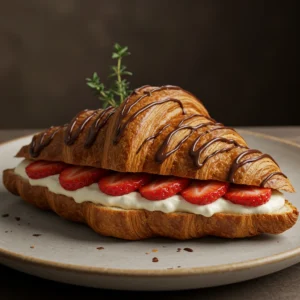
Strawberry Sourdough Croissants
Equipment
- 1 Stand mixer Used for mixing dough
- 1 Rolling pin Used for rolling dough and butter block
- 1 Parchment paper Used for rolling butter into a block
- 1 Pastry brush Used to apply egg wash on the croissants
- 1 Piping bag Used for filling croissants with strawberry cream
- 1 Saucepan Used for making strawberry pastry cream
- 1 Oven For baking the croissants
- 1 Refrigerator Used for chilling dough and croissants
- 1 Plastic wrap For wrapping dough and butter block
Ingredients
- Amount Unit Name Notes
- 600 g grams All-purpose flour
- 65 g grams Granulated sugar
- 12 g grams Salt
- 60 g grams Active sourdough starter 100% hydration
- 205 g grams Water Room temperature
- 112 g grams Whole milk Room temperature
- 56 g grams Unsalted butter Cut into ½-inch pieces chilled
- 1.5 g grams Active dry yeast optional
- 40 g grams Freeze-dried strawberries Crushed
- N/A N/A Plant-based food coloring For light pink dough optional
- N/A N/A Red plant-based food coloring For dark pink dough optional
- 25 g grams Freeze-dried strawberries Whole and pieces soaked in water for topping dough
- 170 g grams Fresh strawberries Stemmed for filling croissants and making strawberry milk
- 340 g grams Unsalted butter 84-86% butterfat for butter block
- 1 unit Egg yolk For egg wash
- 1 Tbsp tablespoon Heavy cream For egg wash
- 500 g grams Whole milk For strawberry pastry cream
- 67 g grams Granulated sugar For strawberry pastry cream
- 40 g grams Cornstarch For strawberry pastry cream
- 2 units Large egg yolks For strawberry pastry cream
- 2 tsp teaspoons Vanilla bean paste Or vanilla extract for pastry cream
- ¼ tsp teaspoons Salt For pastry cream
- 150 g grams Fresh strawberries Optional pureed for pastry cream
Instructions
- Day 1: Prepare the Dough
- Optional: Make strawberry milk by blending milk and fresh strawberries.
- Mix the dough (détrempe) by adding flour, sugar, salt, milk (or strawberry milk), sourdough starter, water, food coloring, crushed freeze-dried strawberries, and optional yeast in a stand mixer. Mix on low, add butter, and continue mixing until smooth.
- Make dark pink dough by adding more food coloring to a portion of the dough.
- First rise: Let both doughs rise at room temperature for 3-6 hours, then refrigerate overnight (~12 hours).
- Make the butter block: Beat butter into a square shape using parchment paper, then refrigerate.
- Day 2: Laminating the Dough
- Prepare dough for laminating by rolling it into a square and freezing for 20 minutes.
- Roll dough, lock in the butter, and perform the first turn (book fold). Rest dough in the freezer and refrigerate for 1 hour.
- Perform a simple turn to create more layers, refrigerate for 1 hour.
- Add the red dough layer on top of the pink dough, roll out to a large rectangle, and refrigerate overnight.
- Day 3: Shaping and Baking
- Slice the dough into rectangles, then cut each rectangle into triangles. Roll each triangle into croissants.
- Proof the croissants at room temperature or with steam for 2-6 hours.
- Preheat oven, egg wash the croissants, and bake at 375°F for 15-30 minutes until golden brown.
- Optional: Fill croissants with strawberry pastry cream.
Notes
- Adding active dry yeast to the dough is optional but can help with fermentation.
- For a more vibrant strawberry flavor, optional steps like making strawberry milk or adding pureed strawberries to the pastry cream are recommended.
- Be sure to let the dough rest for proper layering and texture, which contributes to the flaky nature of the croissants.
Check out our latest article for more insights, and follow us on Facebook for updates! and connect with us on Pinterest and YouTube for more inspiration
By: Sofia

